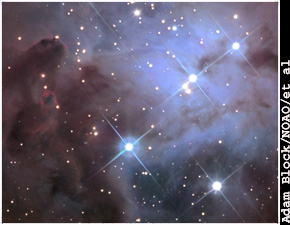Suit up for Winter Observing
A few simple measures let you venture out under the winter stars in complete comfort no matter what the temperature.
by
John Shibley
Outside a frosted window, the winter Milky Way cascades overhead with its
icy-bright stars, glistening open clusters, and splashy, glowing gas clouds. Inside, where summer still prevails, you recline
on the couch, television remote in hand, muttering If only it were warmer outside. Not far away, a trusty telescope or pair
of binoculars lies hibernating in a snug closet like a slumbering bear. The furnace's reassuring sound kicks in, but it hardly
offsets the periodic pangs of guilt you feel. Another gloriously clear night wasted.
Indeed, winter reduces even the most avid skywatchers to wintertime door-stoop
astronomers who glance quickly at a crescent Moon or an occasional grouping of planets. But it doesn't have to be that way.
A moderate amount of effort and cold-weather savvy can eliminate what stands between you specifically the cold weather and
an enjoyable evening under winter's brilliant skies.
Think Layers
First of all, dump the guilt. Eons of evolution
have dictated that almost all living creatures should consider warmth a good thing. Accordingly, your instincts every fiber
in your being say to forget star clusters until spring. But here's where it pays to be a sentient being. You know how to take
the warmth with you under the stars. The source: your body; the means: layers of trapped air.
That's what the army concluded after spending (it's rumored) millions of
dollars on how to dress for cold weather. It's not necessarily the material that traps heat, but layers of still air. Hence
the secret to winter warmth is to insulate with air. Dead air forms a buffer between your heat-releasing skin and the cold,
clear night that seeks to suck every joule of infrared energy out of your body.
The best way to accumulate dead air is to create pockets of it. Dress in
several layers to create at least three inches of insulation (again, the army study) between you and the night. And make sure
these layers are loose, so blood circulation won't get cut off.
Torso and Brain First
Pay particular attention to your
body's torso. That's where most of the vital organs reside. An evolutionary trip-wire shunts blood away from your extremities
(like fingers and toes, followed by arms and legs) toward the torso's organs if it senses things are getting too nippy.
Cover it with a T-shirt, then layer on a turtleneck, a heavy wool sweater
(that alone has thousands of air pockets), topped by a winter jacket with fiber-fill insulation.
Aside from protecting what's inside the torso, this autonomic reflex kicks
in for another vital organ. If the brain's heat loss becomes extreme, blood vessels in the toes and fingers constrict so the
brain gets more blood. In extreme instances, this reflex will even sacrifice limbs to the ravages of frostbite.
Long before that happens, though, your toes and fingers will feel cold
and clammy. So the secret to keeping your extremities warm lies in literally keeping a lid on heat loss through the head.
Keep it covered, which means the top, cheeks, ears . . . whatever can hand off heat. This is where a balaclava comes in handy.
If your winter jacket has a hood, all the better.
They Aren't Expendable
But let's not assess the brain and
other internal organs complete blame if your fingers and toes get uncomfortable. Your digits themselves surrender heat. Again,
the secret to keeping them warm lies in layers.
For the fingers, start with cotton (which draws perspiration away from
the skin) glove liners topped by wool mittens. Such liners assure a certain measure of dexterity if you must doff the mitts
to insert an eyepiece into the telescope.
You won't need such flexibility when it comes to your feet, unless you
insert eyepieces in unorthodox ways. Slip feet into light cotton socks covered by wool socks, all inside oversized snowmobile
boots lined with felt. Some grizzled winter observers advise going with a boot one size larger to accommodate still more layers
of socks. Again, don't pack things too tightly; many a skywatcher has suffered clammy feet brought on by a lack of blood circulation.
Finally, one big area of real estate lies between feet and torso. Cover
your legs in long underwear, heavy wool pants, and a thin nylon wind shell for durability when kneeling on the ground. A waterproof
wind shell might be useful, in case it's damp and cold.
Embrace Low-Tech
One word from the wise: Be wary of high-tech
garments that promise warmth at any temperature. So-called winter activity wear assumes you'll be doing a fair amount of heavy
activity like skiing or snowshoeing. In reality, observing entails long periods of inactivity, save for the occasional elevated
heartbeat when the Orion Nebula drifts through an eyepiece's field of view. For the observer's purpose, cotton to absorb perspiration
and wool to trap body heat does just fine.
With this air of simplicity in mind, suit up like a medieval knight and
awake your slumbering scope for a ride under the stars. Wrapped in layers of wool and cotton, you'll be protected within a
climatic cocoon of spring-like temperatures. Enjoy yourself, for in a few months summer returns with a vengeance to quash
that primal urge to stay close to heating vents.

